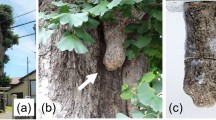Summary
Compression wood in the ancient Ginkgo biloba differs from that in most of the younger gymnosperms in the more angular outline of its tracheids, their thinner walls, and their lack of helical cavities. Both normal and compression woods of Ginkgo contain two types of tracheids, one wide, with a thin wall, and another, narrow, with a thicker wall. In all other respects the compression wood tracheids in Ginkgo are ultrastructurally similar to those in other gymnosperms. Helical cavities probably developed relatively late in the evolution of compression wood, since they are missing not only in Ginkgo but also in the Taxales and the Araucariaceae. The occurrence of compression wood in Ginkgo biloba indicates that this tissue probably has existed since the Devonean period. Very likely, the arborescent habit of the gymnosperms has always been dependent on their ability to form compression wood.
Similar content being viewed by others
References
Andrews, H. N., Jr. 1947. Ancient Plants and the World They Lived in. Comstock Publisher Associates, Ithaca, New York. 279 p.
Bailey, I. W. 1933. The cambium and its derivative tissues. VII. Problems in identifying the wood of Mesozoic Coniferae. Ann. Bot. 47: 145–157
Beck, C. B. 1960. The identity of Archaeopteris and Callixylon. Britt. 12: 351–368
Beck, C. B. 1962. Reconstruction of Archaeopteris and further consideration of its phylogenetic position. Amer. J. Bot. 49: 373–382
Beck, C. B. The appearance of gymnospermous structure. Biol. Rev. 45: 379–400
Böning, K. 1925. Über den inneren Bau horizontaler und geneigter Sprosse und seine Ursachen. Mitt. Deutsch. Dendrol. Ges. 35: 86–102
Casperson, G. 1968. Anatomische Untersuchungen am Lärchenholz (Larix decidua Miller). Faserforsch. Textiltech. 19: 467–476
Côté, W. A., Jr.; Day, A. C.; Kutscha, N. P.; Timell, T. E. 1967. Studies on compression wood. V. Nature of the compression wood formed in the early springwood of conifers. Holzforschung 21: 180–186
Côté, W. A., Jr.; Simson, B. W.; Timell, T. E. 1966. Studies on compression wood. II. The chemical composition of wood and bark from normal and compression regions of fifteen species of gymnosperms. Svensk Papperstid. 69: 547–558
Eicke, R. 1964. Ginkgo biloba. Entwicklungszustand des Holzes und seines Feinbaus. Ber. Deutsch. Bot. Ges. 77: 379–384
Eicke, R.; Ehling, E. 1965. Die Ausbildung der jungen Tracheiden im Holz von Ginkgo biloba L. Ber. Deutsch. Bot. Ges. 78: 326–337
Fengel, D.; Stoll, M. 1973. Über die Veränderungen des Zellquerschnitts, der Dicke der Zellwand und der Wandschichten von Fichtenholz-Tracheiden innerhalb eines Jahrringes. Holz-forschung 27: 1–7
Franklin, A. H. 1959. Ginkgo biloba L.: Historical summary and bibliography. Virginia J. Sci. 10: 131–176
Fukazawa, K. 1974. The distribution of lignin in compression- and lateral-wood of abies sachalinensis using ultraviolet microscopy. Res. Bull. Coll. Exp. For. Hokkaido Univ. 31 (1): 87–114
Greguss, P. 1958. Some recent data on the xylotomy of the Cycas, Zamia and Ginkgo. Acta Biol. Szeged, 4: 143–147
Greguss, P. 1967. Fossil Gymnosperm Woods in Hungary. Akadémiai Kiadó, Budapest, 136 p., 86 plates
Hadfield, M. 1960. Some notes on the Ginkgo. Quart. J. For. 54: 331–337
Harris, R. A. 1976. Characterization of compression wood severity in Pinus echinata Mill. IAWA Bull. 1976 (4): 47–50
Höster, H.-R. 1971. Das Vorkommen von Reaktionsholz bei Tropenhölzern. Mitt. Bundesforschungsanst. Forts-Holzwirtsch. Reinbek, No. 82: 225–231
Kennedy, R. W.; Farrar, J. L. 1965. Tracheid development in tilted seedlings. In: Côté, W. A., Jr. Ed.: Cellular Ultrastructure of Woody Plants. Syracuse University Press, Syracuse. 601 p. 419–453
Lämmermayr, L. 1901. Beiträge zur Kenntnis der Heterotrophie von Holz und Rinde. Sitzungsber. kaiserl. Akad. Wiss. Math.-Naturwiss. Classe, Wien Pt. 1, 110: 29–62
Major, R. T. 1967. The Ginkgo, the most ancient living tree. Science 157: 1270–1273
Marey, P. R.; Morey, E. D. 1969. Observations on Epon embedded Griffin Hill peat (Massachusetts), Two Creeks Picea (Wisconsin), Cedrus penhallowii (Sierra Nevada, California) and Callixylon (Delaware, Ohio). Paleontographica 125: 73–80
Morey, P. R.; Morey, E. D. 1971. Anatomy of a lignitized wood from Senftenberg. Amer. J. Bot. 58: 621–626
Onaka, F. 1949. Studies on compression and tension wood. Mokuzai Kenkyo, No. 1, Wood Res. Inst. Kyoto Univ. Kyoto, 88 p. Translated: Canada, Dept. North. Affairs Natl. Resources, Transl. No. 93, April 1956, 99 p.
Patel, R. N. 1963. Spiral thickening in normal and compression wood. Nature 198: 1225–1226
Patel, R. N. 1968. Wood anatomy of Podocarpaceae indigenous to New Zealand. 3. Phyllocladus. N. Z. J. Bot. 6: 3–8
Seward, A. C. 1938. The story of the maidenhair tree. Sci. Progr. 32: 420–440
Seward, A. C.; Gowan, J. 1900. The maidenhair tree (Ginkgo biloba L.). Ann. Bot. 14: 109–154
Sporne, K. R. 1965. Morphology of Gymnosperms: Structure and Evolution of Primitive Seed-Plants. Hutchinson University Library, London. 216 p.
Srivastava, L. M. 1963. Cambium and vascular derivatives of Ginkgo biloba. J. Arnold Arbor. 44: 165–192
Timell, T. E. 1960. Studies on Ginkgo biloba L. I. General characteristics and chemical composition. Svensk Papperstid. 63: 652–657
Timell, T. E. 1978a. Compression Wood in Gymnosperms. Volume I. Properties of Compression Wood. Springer-Verlag, Berlin, Heidelberg, New York. In press
Timell, T. E. 1978b. Helical thickenings and helical cavities in normal and compression woods of Taxus baccata. Wood Sci. Technol. 12: 1–15
Timell, T. E.; Jabbar Mian, A. 1960a. Studies on Ginkgo biloba L. II. The constitution of an arabino-4-O-methylglucurono-xylan from the wood. Svensk Papperstid. 63: 769–774
Timell, T. E.; Jabbar Mian, A. 1960b. Studies on Ginkgo biloba L. III. The constitution of a glucomannan from the wood. Svensk Papperstid. 63: 884–888
Westing, A. H. 1965. Formation and function of compression wood in gymnosperms. Bot. Rev. 31: 381–480
Author information
Authors and Affiliations
Additional information
This investigation was carried out under the McIntire-Stennis Program, Cooperative State Research Service. I am indebted to Mr. A. C. Day of this College and to Mr. A. Rezanowich of the Pulp and Paper Research Institute of Canada for kindly providing the scanning electron micrographs.
Rights and permissions
About this article
Cite this article
Timell, T.E. Ultrastructure of compression wood in Ginkgo biloba . Wood Sci. Technol. 12, 89–103 (1978). https://doi.org/10.1007/BF00350815
Received:
Issue Date:
DOI: https://doi.org/10.1007/BF00350815




